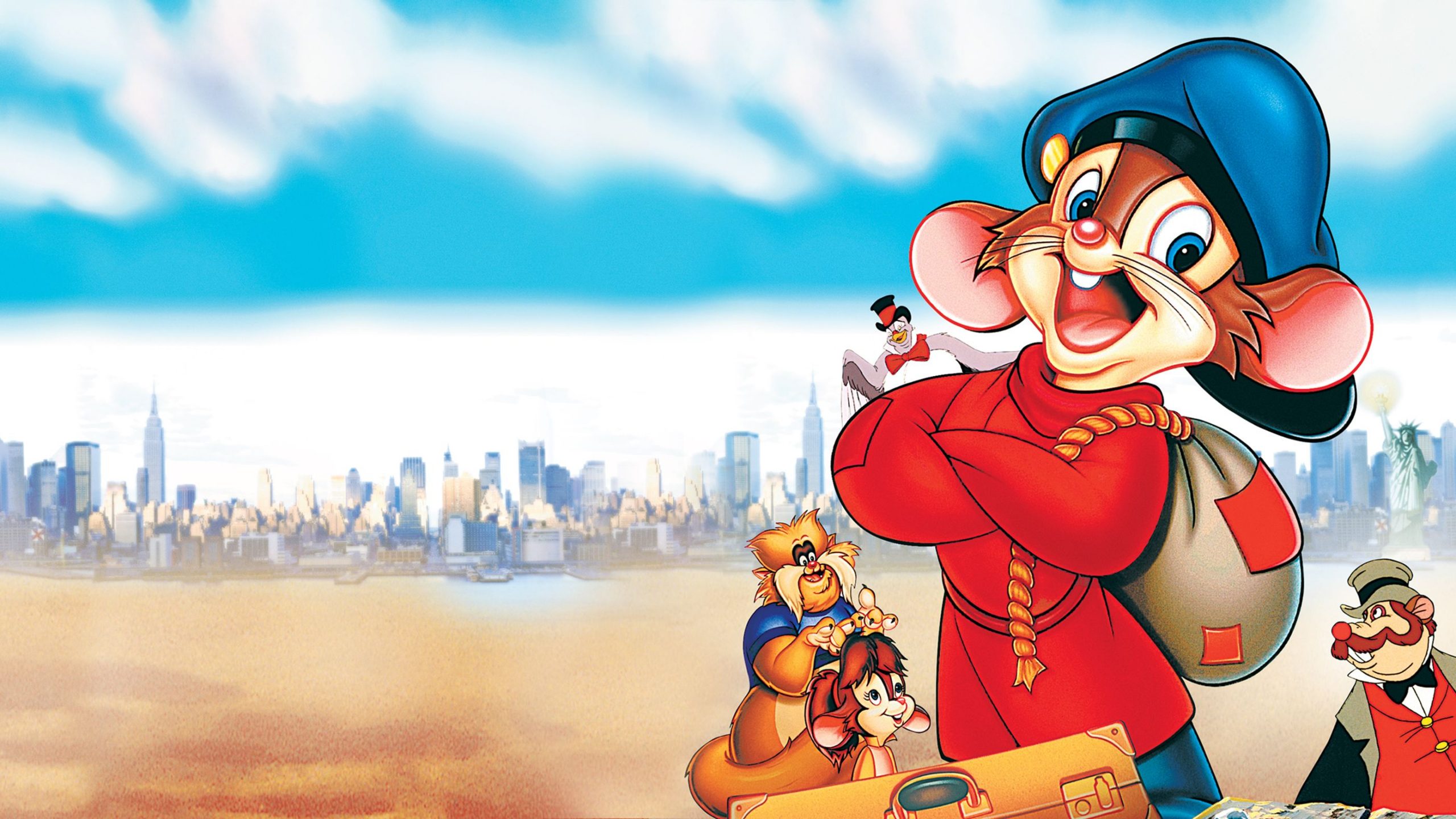“There are no cats in America“
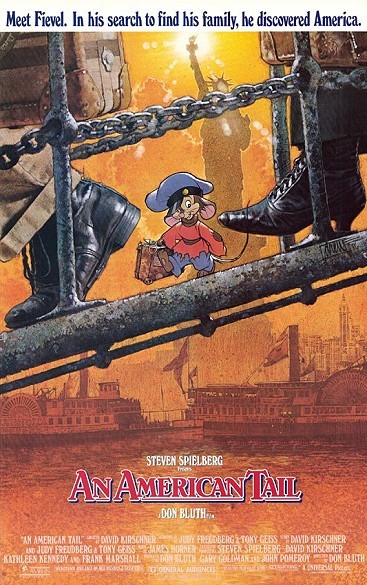
Don Bluth’s An American Tail is a 2D animation family film in which the human drama of religious persecution, poverty and immigration at the end
of the 19th century is narrated through the eyes of a Russian Jewish family
of mice, the Mousekewitz, and particularly through Fievel, the seven-year-old son. As it is often the case in stories with a mouse occupying the leading role, the villain counterpart is predominantly represented by the cat. The classic chasing premise between cats and mice serves in the opening scene to present the anti-Semitic historical context, involving the oppression and persecution of the Jews in the Russian Empire.
Although this dark background will almost surely go unnoticed to a young audience, there is no doubt of who the “good guys” and the “bad guys” of
the film are, even before the cats appear onscreen. The film begins with the Mousekewitz family cheerfully celebrating Hanukkah, with a light-hearted soundtrack accompanying the handing of the presents and the telling of bedtime tales minutes before the horror of the pogrom takes place. The general cosiness and warmth of the scene contrast with the scarcity and precariousness that the family live with, under the constant threat that the felines entail. This can be perceived in the way Mama Mousekewitz reprimands her husband whenever he mentions the cats, fearful that such action could summon them [fig.3]. As many real immigrants at the time, Papa Mousekewitz often daydreams about the “New World”, idealising it and getting carried away by rumours. The later proved erroneous claim “there are no cats in America”, illustrates how Papa believes they will be safe away from the cats [1], in what he considers a freer land.
When narrating the fairy-tale of the “Giant Mouse of Minsk”, Papa describes it to the children as “tall as a tree”. The unnatural size is the only mentioned characteristic about this fantastic animal and, by doing so, the traditional image of the little mouse is altered. In words of Disney animator Frank Thomas “In folklore and legend, the mouse is never the attacker (…) is always depicted as a helpless little guy. [2]”


The size of the real mouse prevents it from defending itself by confronting bigger predators, consequently putting it in the underdog position, or as it happens during the pogrom scene, the fleeing victim. It would make sense then, that when mice tell tales about heroes or magical powers, they enhance the dimensions more than anything else, to become for once the ones scaring the cats away.
When it comes to human – animal relations, interaction is rather infrequent. In An American Tail the animal world and the human world co-exist, but rarely mingle. The presence of humans, however noticeable throughout the film, is brief and mostly relegated to a background position. It serves nonetheless, as a way to establish a clear comparison of similarity between them. The animal society consistently mirrors the human, experiencing parallel adversities resulting from the historical period [fig.5] mostly imperceptibly to the human eye[3]. An example of this takes place during the first minutes of the scene, with the establishing panning shot that connects of the houses of the human family, the Moskowitz, and the mice family, the Mousekewitz [fig.4].
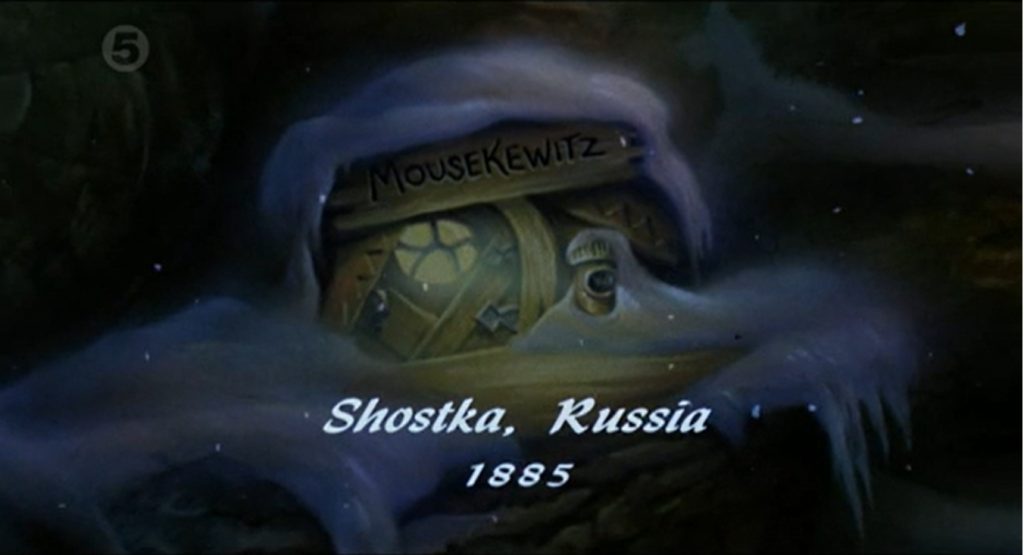
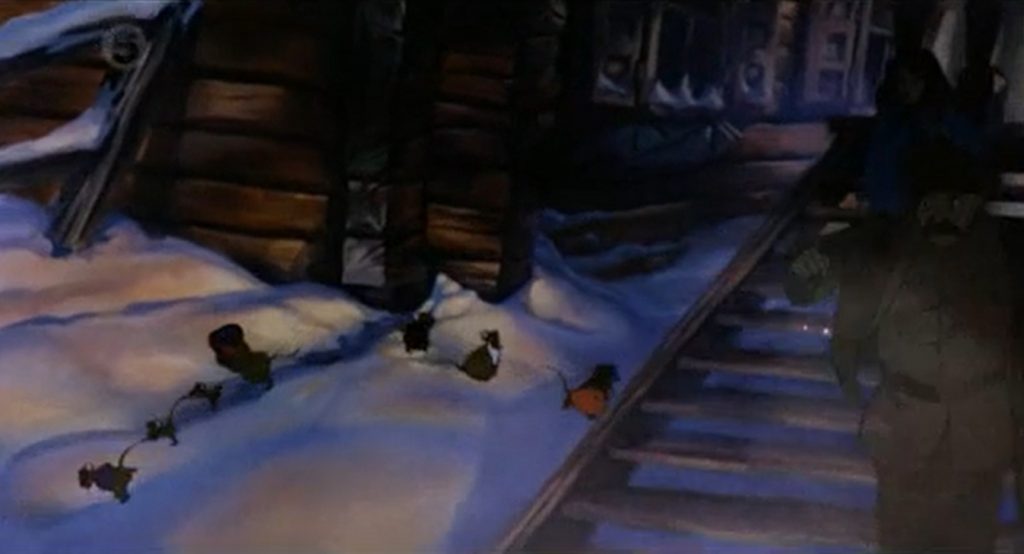
The film’s treatment of animals is not homogeneous, as it makes distinction between species. While mice, cats, or pigeons appear anthropomorphised – talking, dressed, playing instruments and mimicking their human “counterparts”-, horses in this scene are given no agency, lack any sort of so called human abilities, and the artistic approach to their design is more serious and realistic. By doing so, they seem disconnected from Fievel and the narrative, and the audience perception of them differs from that of the rest of the animals [fig. 6,7].
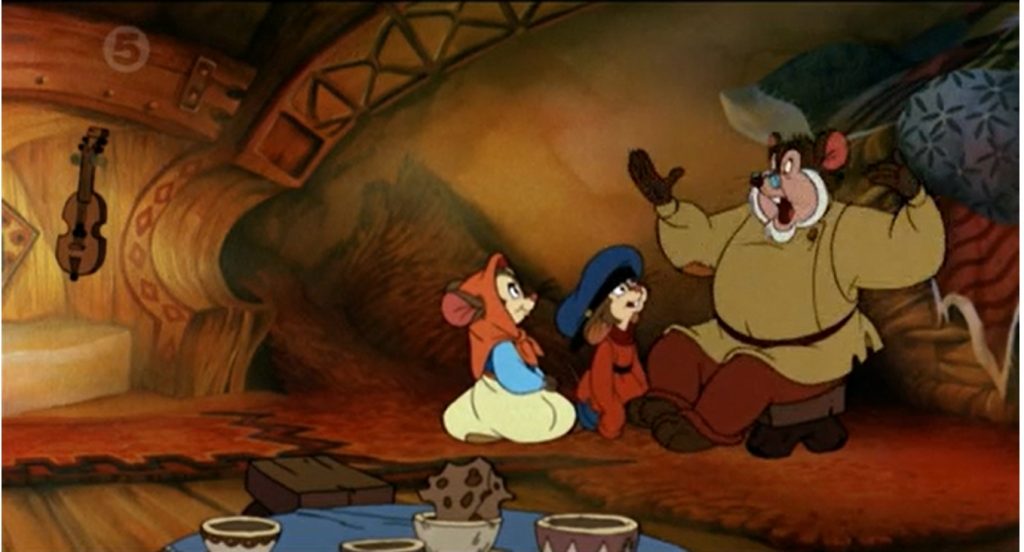
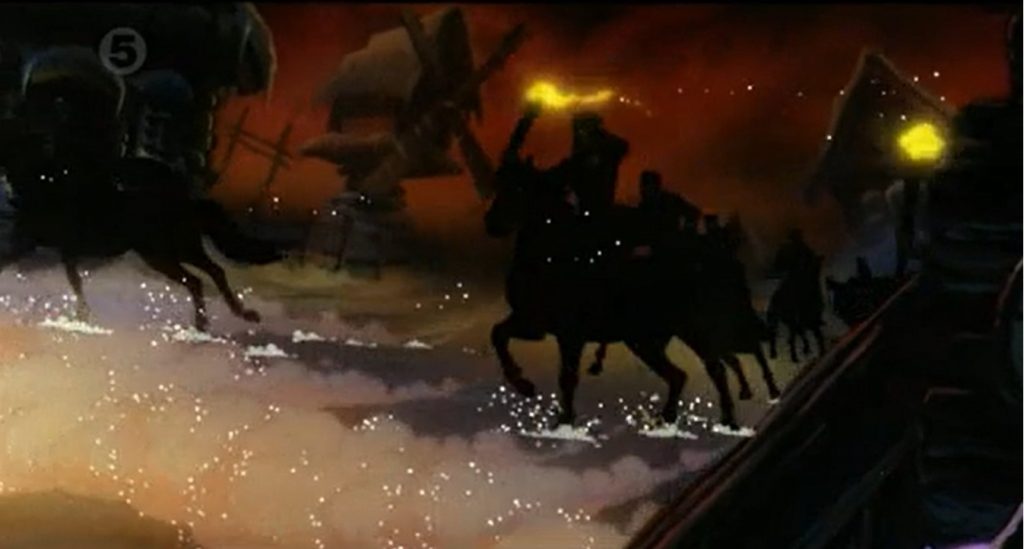
Fig 7. The Cossacks and their horses are dark and ominous. They are mostly silhouettes that can barely be identified.
The animal’s characterisation is meaningfully assigned to contextualise and make sense of the scene in a historical manner. The extremely animalised-animal portrayal of the feline Cossacks connects with the bestiality and barbarism of the killings [fig.6], while the movement in unison depicts them as soldiers of an army. Such representation includes excessive drooling, menacing looks and deep, aggressive roaring and growling. All of it creates a completely demonised version of the cat, yuxtaposed to the kind and defenceless mouse.
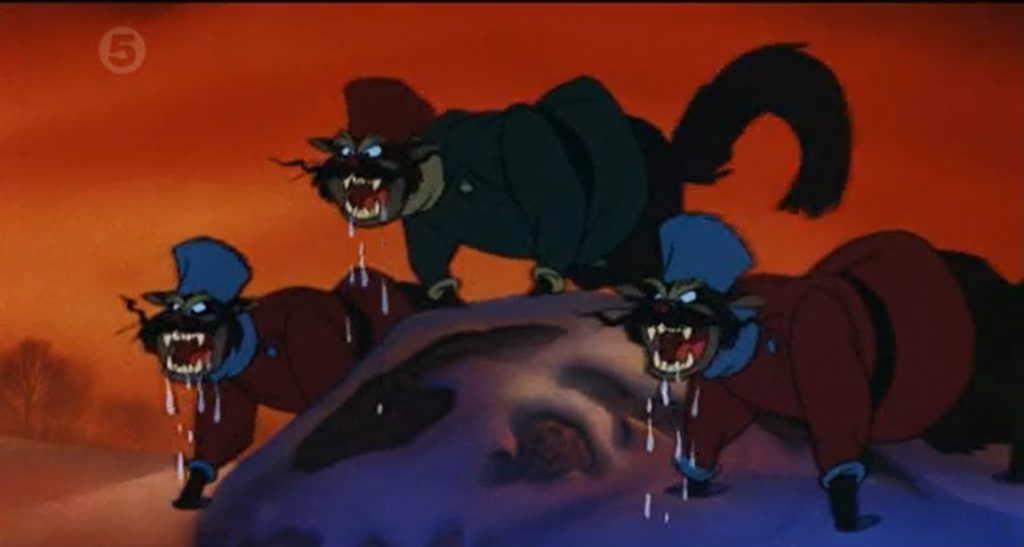
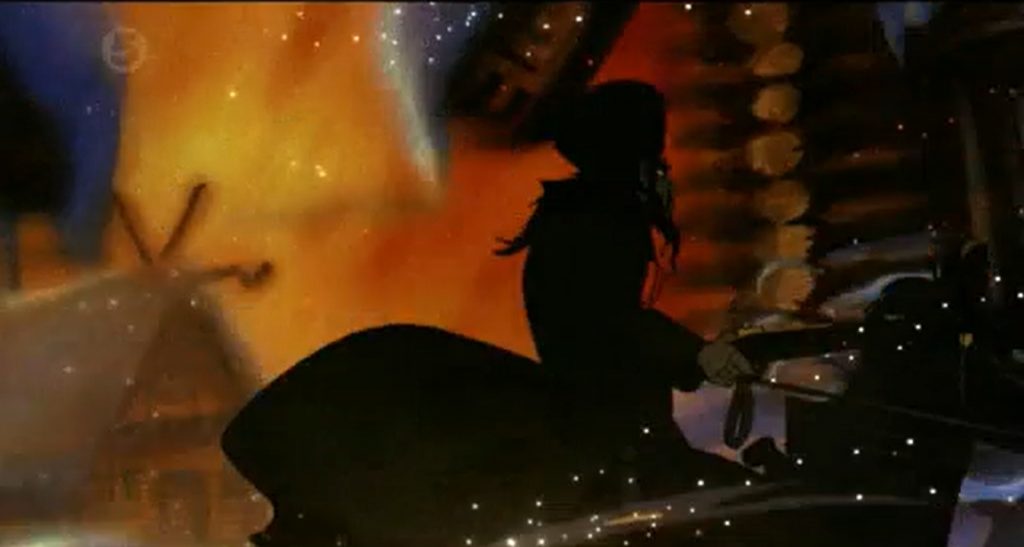
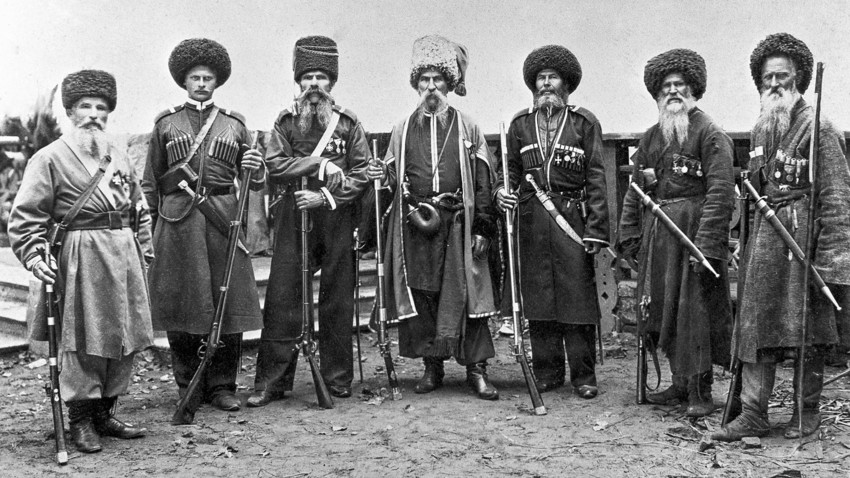
Footnotes
[1] Not all cats in the film are Cossacks, nor all mice are Jewish or Russian. The word “cats” is most likely to be used here to embody the root of the family’s problems altogether. However, for the film to remain consistent, Papa’s belief in this statement needs to be understood at face value, and either consider that he truly means there are no cats in America at all, or that he thinks cats in other parts of the world exist, but are somehow different to the ones in Russia, and therefore they would not be concerned with religious or ethnic matters. The truth is, there are indeed cats in America, and they still personify danger. This situation leaves the mice – cat issue reduced again to its most basic and unoriginal form, that of a Manichean portrayal (with the odd exception of Tiger in the film).
[2]Charles Solomon, ‘Of Mice and the Men Who Draw Them’, Los Angeles Times, 3 January 1987 <https://www.latimes.com/archives/la-xpm-1987-01-03-ca-2106-story.html> [accessed 9 November 2022]
[3] “Don Bluth suggested featuring an animal world existing as a hidden society from the human world” IMDb, IMDb, 1990 <https:// www.imdb.com/> [accessed 2 November 2022]
Further readings:
Boivin, Genia. 2019. ‘America Does Not Want Bad Kitties. The Representation of Cats in “An American Tail”’, animationstudies 2.0 <https://blog.animationstudies.org/?p=3341> [accessed 10 November 2022]
Cawley, John (1991). “An American Tail”. The Animated Films of Don Bluth. Image Pub of New York. pp. 85–102
Cawley, John. [n.d]‘An American Tail’ http://www.cataroo.com/DBtail.html [accessed 10 November 2022]
Jewish Virtual Library, ‘Modern Jewish History: Pogroms’, [1998] <https://www.jewishvirtuallibrary.org/pogroms-2> [accessed 2 November 2022]
Solomon, Charles “Movie Review : ‘American Tail’ Lavishly Disappoints”, Los Angeles Times, 22 November 1986 <https://www.latimes.com/archives/la-xpm-1986-11-22-ca-15108-story.html> [accessed 28 December 2022]
Solomon, Charles ‘Of Mice and the Men Who Draw Them’, Los Angeles Times, 3 January 1987 <https://www.latimes.com/archives/la-xpm-1987-01-03-ca-2106-story.html> [accessed 9 November 2022]
Figure 8: Sputnik. N.d. figure 8, The Kuban’ Cossacks, end of the 19th century, Russia Beyond, 26 July 2020, <https://www.rbth.com/history/332489-who-are-the-cossacks> [2 November 2022]
Bluth, Don, dir., An American Tail (Universal Pictures, 1986)
NorthWind, An American Tail (1986) 1/17 “Main Title Opening”, online video recording, YouTube, 16 September 2022, <https://www.youtube.com/watch?v=x9a4x7AKcDw&list=PLP64eYuPHqbIhkaOQsbz-0mehCBwVLmF9&index=1> [accesed 3 January 2023]
NorthWind, An American Tail (1986) 2/17 “The Cossack Cats”, online video recording, YouTube, 16 September 2022, <https://www.youtube.com/watch?v=kvZfEQ_pMdg> [accessed 3 January 2023]
‘Pogrom Clip from An American Tail’, An American Tail, 15:45 14/07/2013, Channel 5, 90 mins. 00:05:26-00:07:52. https://learningonscreen.ac.uk/ondemand/index.php/clip/226051?bcast=98731495 (Accessed 13 Nov 2022)
